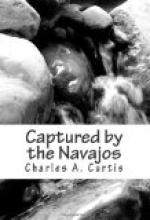We were in the centre of a large valley, with no knowledge of our surroundings nor with any way out except the road by which we had entered. Should we leave the protection of our ridge and cabins and take to the open valley we should be at the mercy of our foes.
Even supposing we could pass out of the valley unmolested, there were the forests and defiles, filled with natural ambuscades. We could not hope to pass them and reach the Rio Grande alive.
Only a few hours of daylight remained. Whatever was to be done in preparation for defence must be done at once.
In the wood-yard there were tiers of dry pine-logs, many of them four feet in diameter, and all about twenty feet long. With drag ropes and by rolling we conveyed them to the points of the ridge and to each end of the guard-house, and erected effective barricades.
While this work was going on the two boys were busy in an attempt to capture the cream-colored pony. Frank led the black towards it, while Henry rattled the contents of a measure of corn and coaxed the cream-color in a tongue foreign to that with which the animals were familiar to approach and partake of it. Tired at last of what seemed a vain attempt, the young corporal set the box before the black, which at once began to munch the crackling corn, and the other pony, attracted by the sound, trotted up and placed her nose beside her friend’s. Instantly its bridle-rein was seized, and the lads uttered a shout of triumph and led the prizes to the stable.
From the top of the ridge I looked occasionally through my field-glass at the enemy. They still continued well to the south on the western side of the brook. They had dismounted and appeared to be carrying on an animated consultation.
After a considerable interval of time, four of their number mounted, and, collecting the ten beeves, mule, and burro, which had been grazing near by, drove them up and down in front of the camp, beyond rifle range. They made gestures for us to come and take them—an invitation which, for obvious reasons, I declined to accept. I quite agreed with Private Tom Clary, who, as he placed his brawny shoulder to a big log to roll it up the slope, remarked to his “bunky,” Private George Hoey, “That’s an invitation, begorra, I don’t fale loike acciptin’.”
“Ye’d niver make yer t’ilet for anither assimbly if ye did, Tom. I don’t think the lutinint will risk the comp’ny’s hair in that way,” replied Hoey.
To have attempted to recover our stock would have necessitated a division of our force, and the main body of the Navajos stood ready to dash in and cut off a party making such a reckless move.
This was what they had originally attempted to accomplish, as I heard years afterwards from a chief who took part in the raid.
Failing to draw us out in pursuit of our lost stock, the Navajos moved slowly away in the deepening dusk to a point close against the forest on the eastern side of the valley and nearly opposite our camp. There they built a row of five fires, which soon became, in the darkness, the only evidence of their presence.




